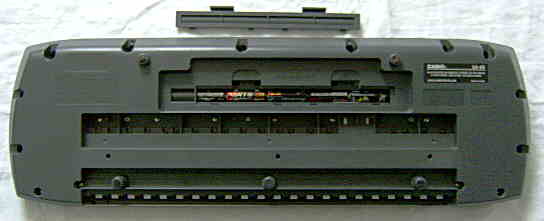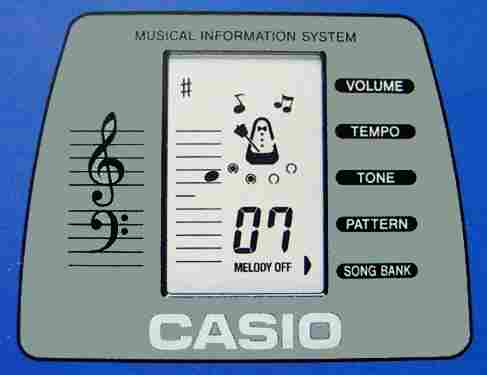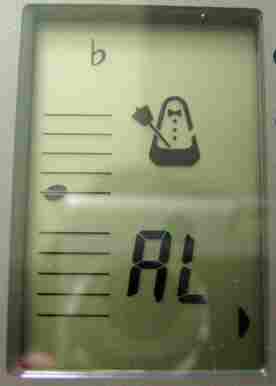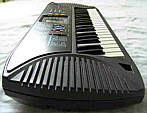| CASIO
SA-65 |
small
keyboard with interesting lo-fi wavetable sounds, LCD display & lovely
demos |
|
|
This keyboard of 1997 (embossed case date) was the top of the line model
of Casio's classic SA-series.
While the sound set corresponds Casio
SA-1, the rhythm set and song bank rather resemble SA-35.
Great is that unlike its predecessors has 37 midsize keys and an LCD which
graphically indicates besides some parameters the position of currently
played notes on note lines. Annoying is that it plays too loud because
volume can not be set lower than medium.
This instrument was later re-released as Casio SA-67 (with silver
control panel and blue display frame).
main features:
-
37 midsize keys
-
2 built-in speakers (ca. 8cm, mono)
-
main voice polyphony 4 notes
-
100 preset sounds (same sound names like Casio
SA-1, selected by 2 digit numbers)
-
30 preset rhythms (selected by 2 digit numbers):
-
rhythm {16 beat, 8 beat, pops, rock, swing, slow rock, shuffle, march,
samba, waltz} (without accompaniment}
-
free session {rap, pops, rock, jazz, house, funk, latin, carnival, country,
classical} (with accompaniment in fixed- key, thus of little use)
-
funny {cheer, fanfare, hopper, computer sound, horror, child's play, orient,
jungle, accident, comedy} (fixed key accompaniment)
-
cipher buttons {"0".."9"} to select preset sounds, rhythms & demos
-
volume +/- buttons (5 steps, reduce bit resolution badly)
-
tempo +/- buttons (16 steps)
-
LCD display (shows parameters, metronome, currently played notes on their
lines)
-
wavetable sound generator with sounds based 2 mixed low- res loop samples
with independent, partly very complex algorithmic volume and pitch envelopes.
-
10 demo melodies song bank (wonderful complex polyphonic orchestrations)
-
"melody off" button (mutes the main voice of the demos to play to them)
-
mulit-chip hardware:
-
CPU= "OKI M6387B-A28,
904231A" (30 narrow pin DIL)
-
LCD controller= "LC75821, 9CD1" (64 pin SMD)
-
AC-adapter jack
 |
 |
 |
eastereggs:
-
3 lower note keys addable.
-
volume control setting changes tempo of algorithmic sound patterns (e.g.
mandolin ring).
notes:
The case construction has unusual waterfall style midsize keys, held by
end tabs visible at case bottom. All sounds of this instrument sound cleaner
and less harsh than in Casio SA-1;
apparently it is better filtered. Unlike other SA keyboards, pressed buttons
play no noises here (likely because the LCD gives visual feedback instead)
and thus don't disturb live performance anymore. Unfortunately the user
interface has a small design flaw: the volume or tempo buttons always switch
the control panel into volume or tempo entry mode (the mode is indicated
by an arrow on the LCD), in which no preset sound or rhythm can be selected
anymore (despite the cipher buttons can not be used for volume/ tempo entry
anyway), thus you have to switch it back by pressing the "tone" or
"pattern" button again each time you select a sound or rhythm after changing
volume or tempo. This is no severe problem since you can access these buttons
with one hand together with the cipher buttons, but it still disturbs some
live play tricks. (Like with other SA series keyboards you can e.g. hold
notes and switch the preset sound or volume, which then only affects new
played notes while the old note keeps playing on its initial sound until
you release the key. Also the pattern speed of ringing mandolins etc. still
changes the known way with the volume setting.) But volume can not be set
lower than average ambient loudness. There is also no sound output jack
despite the PCB has empty solder holes for it; the similarly sized Casio
SA-35 still had one.
The preset sound set resembles very much the 100 ToneBank of
Casio
SA-1 (see there), but by the
longer keyboard you can play 5 additional lower notes here. There are only
few differences; e.g. the "metal guitar" and "metal lead" play a different
chord. Also the split points of split sounds are different (to fit to the
longer keyboard), and the pitch of some non- melodic sounds is different.
A bit annoying is that the "sample percussion" (sort of gong with orchestral
hit) plays here only on a fixed pitch, while on SA-1 many pitches (narrower
than normal tone scale) were distributed over the keyboard. But in comparison
to my Casio PA-31, most
sounds on the SA-65 play a bit more sonorous, more open and clearer, while
the PA-31 sounds more pale and muffled. Generally I like most of the SA-65
timbres better.
The rhythm set resembles much the Casio
SA-35, but has a few additional rhythms. Unfortunately the accompaniments
are still fixed- key and thus badly suited for melody play, but they can
be inspiring for tekkno- like things. The new pattern "cheer" is a squarewave(?)
organ fanfare loop (like from a historical videogame) while "accident"
is a synth loop with ambulance siren and photo camera clicks.
  The
LCD shows 5 parameter values {volume, tempo, sound no., rhythm no., song
no.} one at a time; an arrow indicates the parameter name. When you play
notes, the LCD shows black dots on their note lines, which can be useful
to learn which keys belong to which note pitches. When only naturals (white
keys) are pressed, it displays their note dots simultaneously, while with
sharps (black keys) it cycles through them alternatingly with about 2Hz
by the lack of separate "b" and "#" symbols for the individual notes. It
can only show black dots (like full notes) and not different note characters.
During rhythm or demos a metronome with flashing notes and a walking dot
row is displayed. The
LCD shows 5 parameter values {volume, tempo, sound no., rhythm no., song
no.} one at a time; an arrow indicates the parameter name. When you play
notes, the LCD shows black dots on their note lines, which can be useful
to learn which keys belong to which note pitches. When only naturals (white
keys) are pressed, it displays their note dots simultaneously, while with
sharps (black keys) it cycles through them alternatingly with about 2Hz
by the lack of separate "b" and "#" symbols for the individual notes. It
can only show black dots (like full notes) and not different note characters.
During rhythm or demos a metronome with flashing notes and a walking dot
row is displayed. |
The instrument has a song bank of 10 wonderful orchestrated polyphonic
demo melodies:
-
Ode to Joy
-
Twinkle Twinkle Little Star
-
Santa Lucia
-
Yankee Doodle
-
Minuet (J.S. Bach)
-
On the Bridge of Avignon
-
Silent Night
-
Aura Lee
-
Skaters Waltz
-
Little Brown Jug
They can be played separately or repeated in a sequence. With the "melody
off" button the demo songs can be started with main voice muted to play
to their accompaniment. Unfortunately this button does not take effect
while the music is playing, thus you can not switch back and forward to
simply mute the main voice, improvise a few bars and continue with the
original melody track like on most other keyboards with this feature. Interesting
is that you can switch to different preset sounds (including non-melodic
ones) during demos, those play as their main voice.
hardware details
The Casio SA-65 is based on the CPU "OKI M6387B-A28"
with LCD controller "Sanyo LC75821".
Like other SA series keyboards,
also the SA-65 has a 30 pin CPU of the "OKI M6387" family, but this one
has additionally an LCD controller IC on the back of the PCB. The LCD here
fortunately has 2 silicone contact strips instead of the infamous fragile
Casio foil cable.
keyboard matrix
Because of the longer keyboard, the SA-65 matrix layout strongly differs
from other SA-series instruments. Beside 3 lower note keys there are no
interesting eastereggs.
This matrix is based on the Casio SA-65 service manual.
|
11 KI0
|
12 KI1
|
13 KI2
|
14 KI3
|
15 KI4
|
16 KI5
|
17 KI6
|
18 KI7
|
|
CPU pin
|
|
in 0
|
in 1
|
in 2
|
in 3
|
in 4
|
in 5
|
in 6
|
in 7
|
in / out
|
|
o
A2
|
o
A#2
|
o
B2
|
o
C3
|
o
C#3
|
o
D3
|
o
D#3
|
o
E3
|
out 0
|
30 KO0
|
o
F3
|
o
F#3
|
o
G3
|
o
G#3
|
o
A3
|
o
A#3
|
o
B3
|
o
C4
|
out 1
|
29 KO1
|
o
C#4
|
o
D4
|
o
D#4
|
o
E4
|
o
F4
|
o
F#4
|
o
G4
|
o
G#4
|
out 2
|
28 KO2
|
o
A4
|
o
A#4
|
o
B4
|
o
C5
|
o
C#5
|
o
D5
|
o
D#5
|
o
E5
|
out 3
|
27 KO3
|
o
F5
|
o
F#5
|
o
G5
|
o
G#5
|
o
A5
|
o
A#5
|
o
B5
|
o
C6
|
out 4
|
26 KO4
|
N.
'0'
|
N.
'1'
|
N.
'2'
|
N.
'3'
|
N.
'4'
|
tempo
+
|
melody off
|
select
|
out 5
|
25 KO5
|
N.
'5'
|
N.
'6'
|
N.
'7'
|
N.
'8'
|
N.
'9'
|
volume
+
|
tempo
-
|
volume
+
|
out 6
|
24 KO6
|
|
song bank
|
pattern
|
tone
|
-
|
-
|
start/stop
|
volume
-
|
start/stop
|
out 7
|
23 KO7
|
The input lines are active-high, i.e. react on +Vs. Any functions can
be triggered by a non- locking switch in series to a diode from one "out"
to one "in" pin.
legend:
|
|
|
"o"
|
= keyboard key |
|
N.
|
= numbers (cipher buttons) |
orange
background |
= easteregg |
grey
background |
= unconnected doublet |
pinout LC75821
The "LC75821, 9CD1" (64 pin SMD, service manual name "KS0035") is the
documented LCD controller IC of Casio SA-65. It receives serial
data from a CPU to controll an LCD with up to 53 segment pins.
This pinout is based on the service manual of Casio SA-65 and datasheet
"Sanyo LC75821E, LC75821W".
| pin |
name |
purpose |
| 1 |
S1 |
lcd segment out |
| 2 |
S2 |
lcd segment out |
| 3 |
S3 |
lcd segment out |
| 4 |
S4 |
lcd segment out |
| 5 |
S5 |
lcd segment out |
| 6 |
S6 |
lcd segment out |
| 7 |
S7 |
lcd segment out |
| 8 |
S8 |
lcd segment out |
| 9 |
S9 |
lcd segment out |
| 10 |
S10 |
lcd segment out |
| 11 |
S11 |
lcd segment out |
| 12 |
S12 |
lcd segment out |
| 13 |
S13 |
lcd segment out |
| 14 |
S14 |
lcd segment out |
| 15 |
S15 |
lcd segment out (not used) |
| 16 |
S16 |
lcd segment out (not used) |
| 17 |
S17 |
lcd segment out (not used) |
| 18 |
S18 |
lcd segment out |
| 19 |
S18 |
lcd segment out |
| 20 |
S20 |
lcd segment out |
| 21 |
S21 |
lcd segment out (not used) |
| 22 |
S22 |
lcd segment out (not used) |
| 23 |
S23 |
lcd segment out (not used) |
| 24 |
OPEN |
NC |
| 25 |
S24 |
lcd segment out (not used) |
| 26 |
S25 |
lcd segment out (not used) |
| 27 |
S26 |
lcd segment out (not used) |
| 28 |
S27 |
lcd segment out (not used) |
| 29 |
S28 |
lcd segment out (not used) |
| 30 |
S29 |
lcd segment out (not used) |
| 31 |
S30 |
lcd segment out |
| 32 |
S31 |
lcd segment out |
|
|
| pin |
name |
purpose |
| 33 |
S32 |
lcd segment out |
| 34 |
S33 |
lcd segment out |
| 35 |
S34 |
lcd segment out |
| 36 |
S35 |
lcd segment out (not used) |
| 37 |
S36 |
lcd segment out |
| 38 |
S37 |
lcd segment out |
| 39 |
S38 |
lcd segment out |
| 40 |
S39 |
lcd segment out |
| 41 |
S40 |
lcd segment out |
| 42 |
S41 |
lcd segment out |
| 43 |
S42 |
lcd segment out |
| 44 |
S43 |
lcd segment out |
| 45 |
S44 |
lcd segment out |
| 46 |
S45 |
lcd segment out |
| 47 |
S46 |
lcd segment out |
| 48 |
S47 |
lcd segment out (not used) |
| 49 |
S48 |
lcd segment out (not used) |
| 50 |
S49 |
lcd segment out (not used) |
| 51 |
S50 |
lcd segment out (not used) |
| 52 |
S51 |
lcd segment out (not used) |
| 53 |
S52 |
lcd segment out (not used) |
| 54 |
S53 |
lcd segment out (not used) |
| 55 |
OSC |
clock in |
| 56 |
VDD |
supply voltage +5V |
| 57 |
-INH |
lcd blanking in |
| 58 |
VLCD |
lcd supply voltage +5V |
| 59 |
VSS |
ground 0V |
| 60 |
CE |
chip enable in |
| 61 |
CLK |
bit clock in |
| 62 |
DATA |
data in |
| 63 |
COM2 |
lcd common 1 |
| 64 |
COM1 |
lcd common 2 |
|
|
A new case variant of this instrument was released as Casio SA-75
(different silver metallic case, same features, seen on eBay.) The
case design of Casio SA-65 was blatantly imitated in the Jin
Xin Toys JX-20165 and (less extreme) the Elecking
- My Party Piano.
| removal
of these screws voids warranty... |
|
|
 |

|
|
| |
back
|
|







